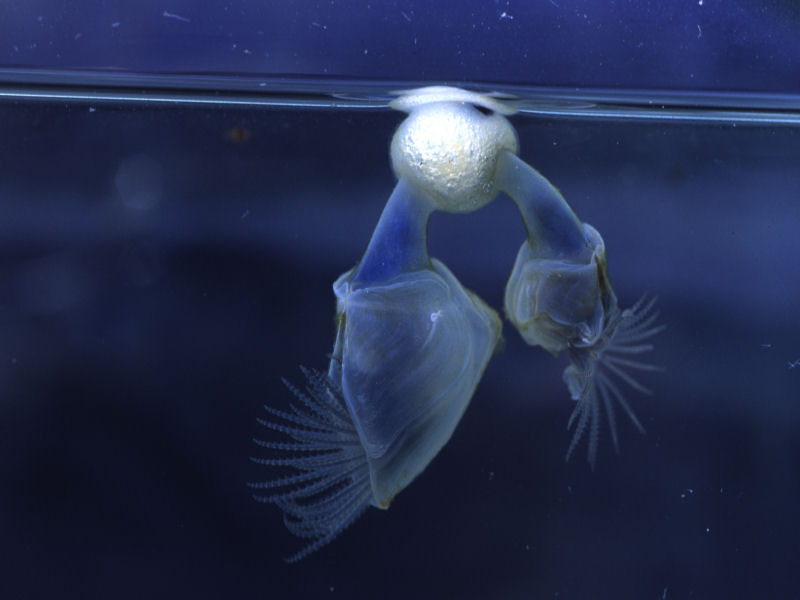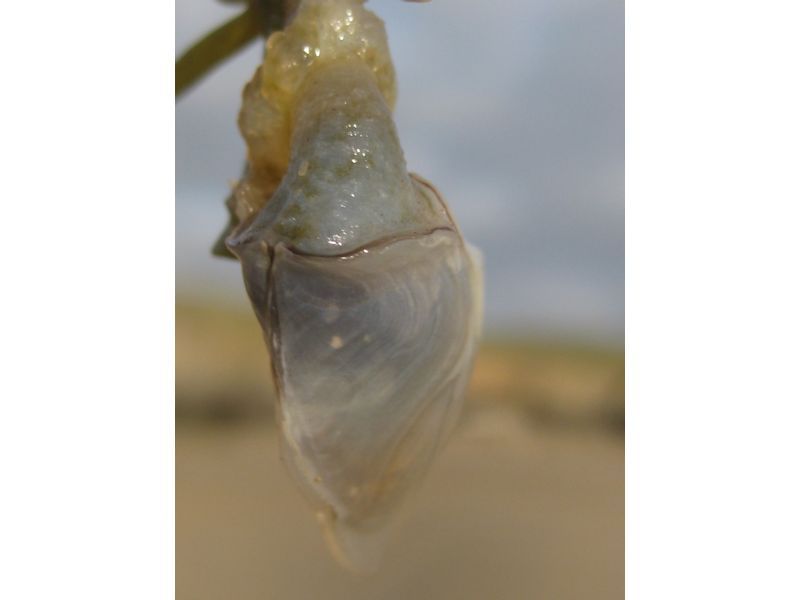Buoy barnacle (Dosima fascicularis)
Distribution data supplied by the Ocean Biodiversity Information System (OBIS). To interrogate UK data visit the NBN Atlas.Map Help
| Researched by | Charlotte Marshall | Refereed by | Admin |
| Authority | (Ellis & Solander, 1786) | ||
| Other common names | - | Synonyms | Lepas fascicularis (Ellis & Solander, 1786) |
Summary
Description
The buoy barnacle Dosima fascicularis is a stalked (pedunculate) barnacle with a swollen head-like capitulum. Like other barnacles, it bears plates (in this case five large ones) although the stalk is naked. The buoy barnacle is markedly different to the acorn barnacles commonly found on rocky shores, especially in size, and closely resembles goose barnacles (see for example Lepas anatifera). It can be pale yellowish to purplish-brown in colour and, although commonly found in small numbers attached to small floating objects, can also be washed ashore in large groups attached to the same object.
Recorded distribution in Britain and Ireland
The buoy barnacle is at home in the warmer waters of the Atlantic and Pacific Oceans but is sometimes stranded in large numbers along the western coasts of Britain and Ireland after south-westerly winds. (Distribution continued in additional information).
Global distribution
-Habitat
The buoy-barnacle, sometimes called the buoy-goose-barnacle, was first noted by James Ellis, who had a specimen from St. George's Channel, and was described by himself and Daniel Solander (1786); see also Pennant (1812). It is distinguished from goose-barnacles of the genus Lepas by its ability to make its own float. The young forms settle on small floating particles in the water, and as they grow they produce a spongy secretion from modified cement glands, comparable in texture to polystyrene, which keeps them near the surface of the water and is increased in volume as the barnacle grows. Darwin described the float in his monograph on the Lepadidae (1851). Other individual barnacles attach to the float and in this way, a large colony is constructed. Sometimes the buoy-barnacle attaches to larger objects including feathers lost from sea birds (Couch, 1841) and even old tar balls that have lost the toxicity of the original crude oil (Minchin, 1996). O' Riordan (1967) reported that it the buoy barnacle had been found attached to Fucus sp. Minchin (1996) suggested that strandings of the buoy barnacle are greater nowadays as a result of extra nuclei available for settlement in the form of man-made plastics and oil globules. Out of interest, an aggregation of Dosima fascicularis was reported from the tail of a yellow-bellied sea snake (Pelamis platurus) in Mexico (Alvarez & Celis, 2004).
Depth range
-Identifying features
- Naked stalk.
- The stalk is shorter than the head.
- Maximum length of head (capitulum) is 3 cm although more commonly 1.2 - 2 cm.
- The capitulum is composed of five plates.
- One of the plates (the carina) is bent and has a prominent umbo, and terminates in a large, flat basal disc.
- The shell plates are thin and papery.
Additional information
Dosima fascicularis was originally known as Lepas fascicularis to Linnaeus and Darwin although it was separated as Dosima by Gray in 1825 (Darwin, 1851).
Recorded distribution in Britain and Ireland (continued). Big strandings have occurred in recent years, in Cornwall on the north coast (e.g. Turk, 1982), and in Ireland in West Cork and counties Mayo and Sligo (Minchin, 1996; Cotton et al., 2006). Such strandings may also include large numbers of the by-the-wind-sailor (Velella velella), the Portuguese-Man-o-War (Physalia physalis), the snail (Janthina sp.) and other members of a community that lives close to the water surface and has been called neuston. The buoy-barnacle is recorded as being stranded also in the Faeroe Islands and southern Norway (Nilsson-Cantell, 1986). There are old records for the North Sea coast of Britain, mentioned by Nilsson-Cantell (1986) and Foster-Smith (2000), but these need validating.
Listed by
- none -
Bibliography
Alvarez, F. & Celis, A., 2004. On the occurrence of Conchoderma virgatum and Dosima fascicularis (Cirripedia, Thoracica) on the sea snake, Pelamis platurus (Reptilia, Serpentes) in Jalisco, Mexico. Crustceana, 77, 761-764.
Bassindale, R., 1964. British Barnacles. London: The Linnean Society of London.[Synopses of the British Fauna, no. 14.]
BMLSS (British Marine Life Study Society) 2006. Barnacles http://www.glaucus.org.uk,
Cotton, D.C.F., Dunleavy, J. & Dick, J.-M., 2006. Buoy barnacle (Dosima fascicularis (Ellis & Solander 1786) mass stranding in Cos Mayo and Sligo. Irish Naturalists' Journal, 28, 223-225.
Couch, J., 1841. A Cornish fauna, being a compendium of the natural history of the country, intended to form a companion to the collection in the museum of the Royal Institution of Cornwall. Part II. The testaceous mollusks. Truro: Royal Institution of Cornwall.
Darwin, C., 1851. A monograph on the sub-class Cirripedia, with figures of all the species. Vol.l - The Lepadidae; or pendunculated Cirripedes. 400 pp. London: Ray Society.
Ellis, J. and Solander, D. 1786. The natural history of many curious and uncommon zoophytes collected from various parts of the globe. Cirripedia, pp. 197-198, plate 15. London: B. White & Sons.
Foster-Smith, J. (ed.), 2000. The marine fauna and flora of the Cullercoats District. Marine species records for the North East Coast of England. Sunderland: Penshaw Press, for the Dove Marine Laboratory, University of Newcastle upon Tyne.
Howson, C.M. & Picton, B.E., 1997. The species directory of the marine fauna and flora of the British Isles and surrounding seas. Belfast: Ulster Museum. [Ulster Museum publication, no. 276.]
Minchin, D., 1996. Tar pellets and plastics as attachment surfaces for lepadid cirripedes in the North Atlantic Ocean. Marine Pollution Bulletin, 32, 855-859.
Nilsson-Cantell, C.A., 1978. Marine Invertebrates of Scandinavia. Volume 5, Cirripedia Thoracica and Acrothoracica. Oslo: Universitets Forlaget.
O'Riordan, C.E., 1967. Cirripedes in Ireland (Irish cirripedes in the collections of the National Museum of Ireland and in the literature). Proceedings of the Royal Irish Academy B, 65, 285-296.
Pennant, T., 1812. British Zoology volume 4, Crustacea, Mollusca, Testacea. London. London.
Datasets
Fenwick, 2018. Aphotomarine. Occurrence dataset http://www.aphotomarine.com/index.html Accessed via NBNAtlas.org on 2018-10-01
Kent Wildlife Trust, 2018. Kent Wildlife Trust Shoresearch Intertidal Survey 2004 onwards. Occurrence dataset: https://www.kentwildlifetrust.org.uk/ accessed via NBNAtlas.org on 2018-10-01.
NBN (National Biodiversity Network) Atlas. Available from: https://www.nbnatlas.org.
OBIS (Ocean Biodiversity Information System), 2025. Global map of species distribution using gridded data. Available from: Ocean Biogeographic Information System. www.iobis.org. Accessed: 2025-07-26
Outer Hebrides Biological Recording, 2018. Invertebrates (except insects), Outer Hebrides. Occurrence dataset: https://doi.org/10.15468/hpavud accessed via GBIF.org on 2018-10-01.
South East Wales Biodiversity Records Centre, 2018. SEWBReC Myriapods, Isopods, and allied species (South East Wales). Occurrence dataset: https://doi.org/10.15468/rvxsqs accessed via GBIF.org on 2018-10-02.
Citation
This review can be cited as:
Last Updated: 06/09/2007




